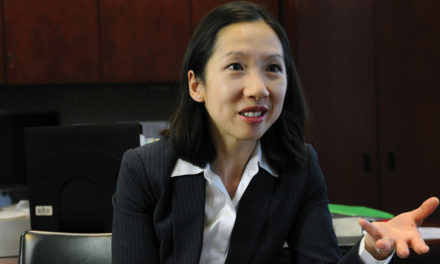On a frigid January afternoon earlier this year, Kevin Dunn stood before a hushed crowd in a darkened theater in Oshkosh, Wis., and delivered a warning. He had come at the behest of several pro-life groups looking to learn more about Belgium’s 15-year experiment with euthanasia.
“The anti-euthanasia movement in Belgium and The Netherlands is like a voice crying in the wilderness: ‘Don’t go there, America!’ ” he said.
A decorated documentary filmmaker, Dunn has traveled to Belgium and The Netherlands over the past two years to document what happens to a society that embraces and hastens the death of some of its most vulnerable citizens—people who are elderly, frail or living with serious illnesses or disabilities. The result of his travels is an hour-long documentary film, The Euthanasia Deception, which he screened for several Wisconsin audiences.
Dunn was pleased with the audience’s response in Oshkosh, but his mission in Wisconsin was more important than simply screening the film. With his home country of Canada, two U.S. states, and the District of Columbia all legalizing assisted suicide within the past year, Dunn feels called to help his southern neighbors boldly confront the agenda pushing America deeper into the valley of death.
Faces of Death
Assisted suicide was little known in the United States until Michigan doctor Jack Kevorkian aided the death of an Oregon woman in 1990. Janet Adkins was the first of a reported 130 suicides he assisted over the next eight years. Kevorkian’s repeated lawlessness forced the issue into public consciousness, and he quickly became its brazen face.
Throughout the 1990s, “Dr. Death,” as he was often called, was tried and acquitted several times before being convicted of second-degree murder in 1999 for personally administering a lethal injection to 52-year-old Thomas Youk of Detroit.
With Kevorkian behind bars, the issue of assisted suicide turned back to the states where assisted suicide forces suffered some losses, but also won a few rounds. Then in 2014, 29-year-old Brittany Maynard was diagnosed with terminal brain cancer, and she and her husband moved from California to Oregon in order to obtain a lethal prescription.
Suddenly, assisted suicide had a fresh, young face. Maynard drew national attention after sharing her story on social media and crusading for laws and ballot measures legalizing doctor-assisted suicide around the country. Millions were moved by her tragic case, which ended on Nov. 1 when she committed suicide by taking the lethal drugs prescribed by her doctor.
Shortly after Maynard died, Art Caplan, a doctor at the New York University Langone Medical Center, predicted in Medscape that her death “may change the politics” of assisted suicide:
“Brittany Maynard, because she’s young, vivacious, attractive, a newlywed, has a dog, and is a very different kind of person from the average middle-aged or older person who has to confront issues about terminal illness, changes the optics of the debate,” he wrote. “Now we have a young woman getting people in her generation interested in the issue.”
Killing Bills, Not People
Caplan may have been right. In 2014, some 20 years after assisted suicide was legalized in Oregon, only three states had laws allowing it: Oregon, Vermont and Washington. Two years later, California, Colorado, and the District of Columbia joined the list. Montana doesn’t have a law, but is guided by a 2009 state court ruling which found that current laws do not forbid the practice.
With two states and Washington, D.C. falling under the shadow of death in the past year, some expect a domino effect among other vulnerable states. Jennifer Lahl, who heads the Center for Bioethics and Culture Network, is among those helping legislators uphold the sanctity of human life at every stage.
“It’s a constant battle to push back bad bills,” she told Citizen
As legislative conflicts intensify, however, pro-life groups are still gaining significant victories. During the most recent legislative session, 28 states introduced bills to legalize assisted suicide. Eight states defeated the bills outright and the rest were tabled to die at the end of the session.
Autumn Leva tracks assisted suicide bills across the country as director of communications and public policy at Family Policy Alliance. She told Citizen the pro-death lobby has been ramping up its agenda in recent years.
“The push for assisted suicide is on the rise,” Leva said. “This issue isn’t going away so long as we see groups like Compassion & Choices funneling so much money into these battleground states.”
Grim Reaper
Founded as the Hemlock Society in 1980, Compassion & Choices took its current name in 2004 and has since seen its influence and budget grow significantly. Behind much of this growth is a man long known for radical social engineering: George Soros.
In a 2016 article titled “The Rise and Rise of America’s Suicide Lobby,” Foundation Watch’s Neil Maghami writes that Soros has been pursuing death at least since 1994 and has given more than $7 million to Compassion & Choices since 2008.
While few realized it at the time, Compassion & Choices was the chief architect behind Brittany Maynard’s end-of-life media blitz. The group helped her produce two viral videos viewed by millions and arranged for a cover spread and exclusive interview with People magazine.
Its strategy to reshape public opinion appears to be working. A 2013 Pew Research Center poll found that only 47 percent of Americans approved of laws “to allow doctor-assisted suicide for terminally ill.” By last December, a LifeWay Research survey found 69 percent supported the ability of physicians “to assist terminally ill patients in ending their lives,” including 70 percent of Catholics, 53 percent of Protestants, and 42 percent of Evangelicals.
These poll numbers reveal a significant problem, says Lahl. Even though many Americans claim to be pro-life, they also embrace an ethic of radical personal autonomy that leads them, perhaps unwittingly, into supporting the culture of death.
“It’s my life, my right, my choice, my freedom,” she said. “I expect this from the larger culture, but how do you make a difference when this is coming from the Church?”
Bad Medicine
With the sympathetic nature of Maynard’s story and the success of the 2016 pro-assisted-suicide film, Me Before You, Leva believes pro-life groups need to do a better job of creating persuasive public arguments that highlight the long-term implications of assisted suicide.
“While we all care about the individuals who are suffering, public policy needs to take into account the needs of all of society,” she said. “What we decide about assisted suicide impacts how we understand the value of life, the medical profession, and many other areas of life.”
Thankfully, pro-lifers may have a new policy ally at the U.S. Supreme Court, Justice Neil Gorsuch. Prior to becoming a federal judge 11 years ago, Gorsuch published a heavily researched book, The Future of Assisted Suicide and Euthanasia (Princeton University Press, 2006).
“We seek to protect and preserve life for life’s own sake in everything from our most fundamental laws of homicide to our road traffic regulations to our largest governmental programs for health and social security,” he wrote. “All human beings are intrinsically valuable and the intentional taking of human life by private persons is always wrong.”
As activists and average citizens alike work to reshape public opinion, assisted suicide opponents agree that at least three distinct points need to be clearly communicated:
- Assisted suicide is an attack on medicine. Promoting killing as a medical treatment upends more than two millennia of medicine’s most basic premise: First, do no harm. For the most part, doctors themselves don’t want to open medicine to the practice. A 2013 poll conducted by the New England Journal of Medicine among its readers found that 65 percent of respondents oppose physician-assisted suicide—and so far, all major U.S. medical associations do as well. The American Medical Association code of ethics states: Physician-assisted suicide is fundamentally incompatible with the physician’s role as healer, would be difficult or impossible to control, and would pose serious societal risks.
In some cases, doctors who formerly supported the practice are having second thoughts for various reasons. The National Post reports that dozens of Ontario doctors have permanently removed themselves from a “voluntary referral list of physicians willing to help people die” in Canada and “another 30 have put their names on temporary hold.”
- Assisted suicide puts vulnerable people at risk. One of supporters’ primary and most effective arguments is that assisted suicide is necessary to alleviate insufferable pain. But opponents point out that palliative care has improved to the point that, as one hospice nurse shared in The Euthanasia Deception, “Almost no one dies in excruciating pain anymore, unless they choose to.”
Critics also fear that people’s genuine compassion for suffering is being manipulated into supporting a less altruistic agenda. This spring, bioethicist Wesley J. Smith told Fox News, “Once society broadly accepts the agenda of killing as an acceptable end to human suffering, we eliminate suffering by eliminating the sufferers.”
This is grimly evident in Belgium, where euthanasia has already been expanded to minors and people not suffering from terminal illnesses. Doctors and hospitals are being forced to participate against their own consciences. Author Michael Cook addressed this fatal “mission creep” recently in the online journal BioEdge: “Euthanasia for psychiatric patients has already happened dozens of times in Belgium. But from now on it will probably be easier for people suffering from schizophrenia, personality disorders, depression, autism, or loneliness to access it.”
Assisted suicide’s restrictions are being breached elsewhere. Less than a year after allowing assisted suicide for terminally ill patients, Canadian legislators are debating whether to open it to those suffering from mental illness, as happened in Belgium. Also, some Canadian doctors are now pushing to harvest organs from assisted suicide victims, and a bill introduced in January in the Oregon Senate—which was still viable as this issue of Citizen went to press—proposes to allow the intentional starvation of patients with dementia or mental illness.
Dunn, the filmmaker, believes he already encountered the newest “death right” during a recent visit to The Netherlands. There he spoke with a euthanasia lobby group which is advocating for a “completed life law” to allow “anyone who feels they have lived a completed life” access to assisted suicide.
- Safeguards are an illusion. Assisted-suicide activists often sell their bad medicine by promoting the use of so-called legal safeguards to protect against abuse. In a statement sent to Colorado residents last December, Compassion & Choices claimed, “There is no evidence of abuse in the five other authorized states with a collective 30+ years of experience with this medical practice.”
But such evidence is difficult to collect when oversight is nonexistent. Dr. Katrina Hedberg of the Oregon Department of Human Services told the media in 2005 that there is no oversight of the law in the state where Brittany Maynard ended her life: “We are not given the resources to investigate [assisted-suicide cases] and not only do we not have the resources to do it, but we do not have any legal authority to insert ourselves,” she said.
Abuses in The Netherlands now encompass newborns and young children—whether or not they are labeled as terminal. In an article appearing in the March 2005 edition of The New England Journal of Medicine, two Dutch doctors defended the existing practice of euthanizing children who don’t have terminal illnesses, “but for whom a very poor quality of life, associated with sustained suffering, is predicted,” even though this violates Dutch law.
Failures in Belgium are almost too numerous to count. One striking illustration was reported in the June 2010 edition of The Canadian Medical Association Journal.
A study conducted in Flanders found that nearly 2 percent of all deaths in the city over five months in 2007 came from involuntary euthanasia. The majority of people were intentionally killed by drug overdoses administered by doctors or nurses in hospitals where they were seeking treatment for their illness.
Final Judgment
Life advocates agree much work is still needed to turn back the tide of assisted suicide. Lahl doesn’t believe the culture will change if the Church stays silent.
“The Church has lost its prophetic voice in the culture,” she said. “It tends to focus on having great music, and being relevant, contemporary and hip, but it’s really fearful of looking political. To preach on these issues makes people think you’re political.”
Dunn is working to help pro-lifers do a better job of telling the both the hard stories of abuse and the beauty of the love that can be given and received at the end of life.
“I interviewed those who have lost loved ones to euthanasia and assisted suicide,” he told Citizen. “They, along with doctors and advocates, are desperate to have their voices heard above the ultra-liberal media.”
At the very end of Dunn’s film screening in Oshkosh, a man said that when his grandfather was dying of bone cancer, he begged to be “put down.” However, as death drew near, the man’s grandfather was able to reconcile with his family.
“Although my grandfather suffered, his suffering had a purpose,” he said. “If we had ended his life early, even for reasons of compassion and mercy, we might have missed out on God’s redemptive grace that will bless our family for generations. The Lord had work for him until the very end.”
For More Information:
To learn more about The Euthanasia Deception, visit vulnerablefilm.com. For more information on pro-life groups fighting this issue, visit Caringnotkilling.com (Caring Not Killing), cbc-network.org(The Center for Bioethics and Culture), or familypolicyalliance.com (Family Policy Alliance).
Originally published in the August 2017 issue of Citizen magazine.






